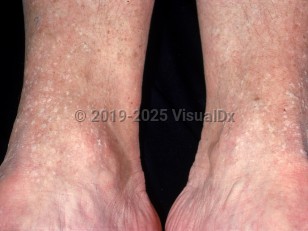Acrokeratosis verruciformis in Adult
Alerts and Notices
Important News & Links
Synopsis

Acrokeratosis verruciformis (AKV) is a rare autosomal dominant genodermatosis characterized by verrucous lesions on the dorsal hands and feet. It typically presents during childhood but can arise in up to the fifth decade.
AKV typically presents with closely grouped verrucous papules on the dorsal hands and feet, elbows, and knees, with occasional punctate keratoses of the acral surfaces. Papules often develop in childhood and increase in number throughout adolescence. They can also be present at birth. Nails may also be affected, with changes including striations, subungual hyperkeratosis, and distal nail V-shaped nicking.
AKV arises from a single genetic defect to the ATP2A2 gene on chromosome 12 that affects calcium transport in the sarcoendoplasmic reticulum and leads to disordered keratinization. The pattern of inheritance of AKV is autosomal dominant with incomplete penetrance, so a positive family history may not always be present. Sporadic cases have also been reported. There is no sex or racial / ethnic predilection.
Much of the published research on AKV has explored its relationship to Darier disease, as both conditions are caused by mutations in ATP2A2, making AKV and Darier disease allelic.
The natural course of the condition is chronic, without spontaneous remission. It is generally benign, but rare cases of malignant transformation to squamous cell carcinoma have been reported.
AKV typically presents with closely grouped verrucous papules on the dorsal hands and feet, elbows, and knees, with occasional punctate keratoses of the acral surfaces. Papules often develop in childhood and increase in number throughout adolescence. They can also be present at birth. Nails may also be affected, with changes including striations, subungual hyperkeratosis, and distal nail V-shaped nicking.
AKV arises from a single genetic defect to the ATP2A2 gene on chromosome 12 that affects calcium transport in the sarcoendoplasmic reticulum and leads to disordered keratinization. The pattern of inheritance of AKV is autosomal dominant with incomplete penetrance, so a positive family history may not always be present. Sporadic cases have also been reported. There is no sex or racial / ethnic predilection.
Much of the published research on AKV has explored its relationship to Darier disease, as both conditions are caused by mutations in ATP2A2, making AKV and Darier disease allelic.
The natural course of the condition is chronic, without spontaneous remission. It is generally benign, but rare cases of malignant transformation to squamous cell carcinoma have been reported.
Codes
ICD10CM:
Q82.8 – Other specified congenital malformations of skin
SNOMEDCT:
400018004 – Acrokeratosis verruciformis of Darier disease
400085009 – Acrokeratosis verruciformis of Hopf
Q82.8 – Other specified congenital malformations of skin
SNOMEDCT:
400018004 – Acrokeratosis verruciformis of Darier disease
400085009 – Acrokeratosis verruciformis of Hopf
Look For
Subscription Required
Diagnostic Pearls
Subscription Required
Differential Diagnosis & Pitfalls

To perform a comparison, select diagnoses from the classic differential
Subscription Required
Best Tests
Subscription Required
Management Pearls
Subscription Required
Therapy
Subscription Required
References
Subscription Required
Last Reviewed:01/24/2022
Last Updated:03/10/2024
Last Updated:03/10/2024
Acrokeratosis verruciformis in Adult

